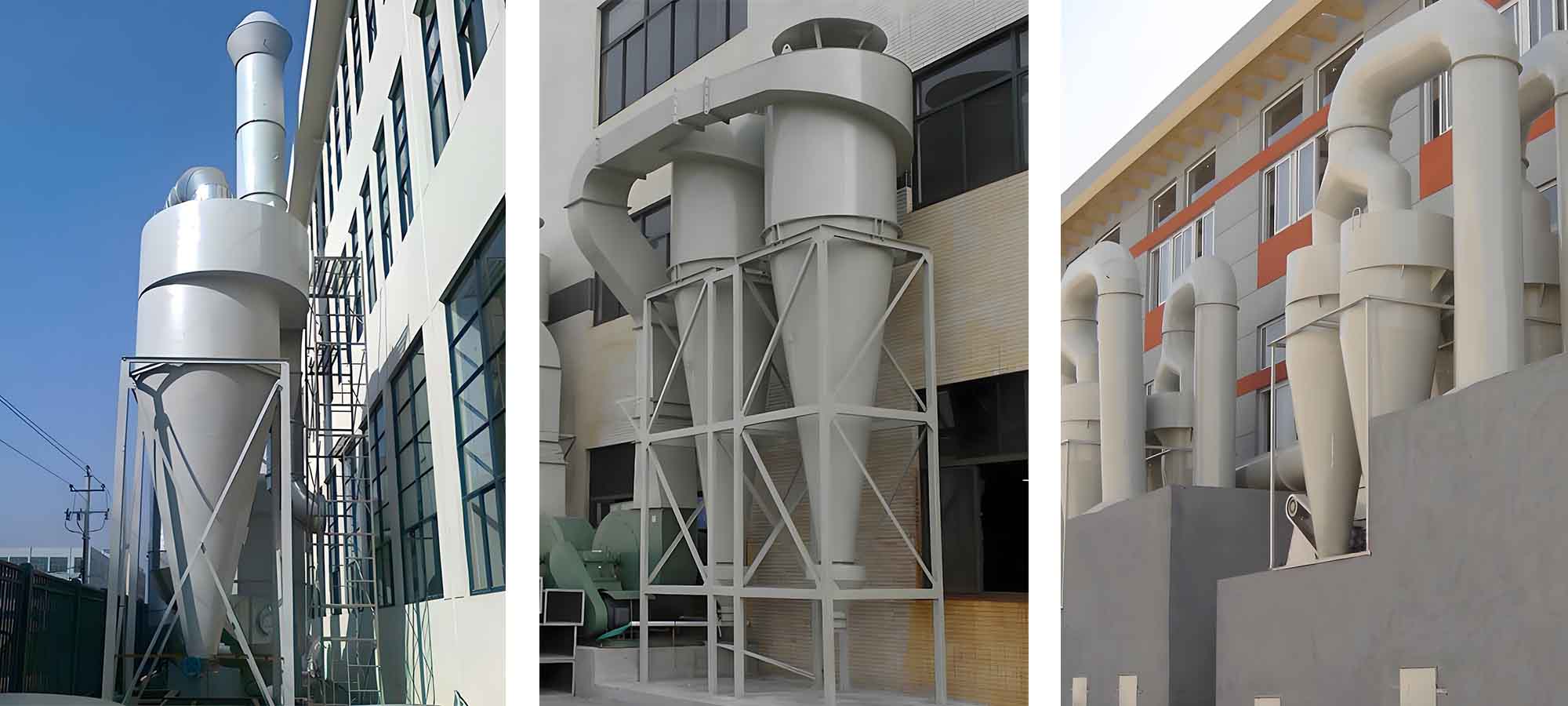A cyclone filter plays a crucial role in 大気汚染防止.各コンポーネントには特定の寸法比があります。これらの比率のどの変更でもコレクターの効率および圧力損失にかなり影響を与えることができます。性能に影響を与える主な要因には、コレクタの直径、入口のサイズ、および出口パイプの直径が含まれます。特定の限度を超えると、有益な要因が有害な要因に変わる可能性があります。さらに、いくつかの調整は集塵効率を高めることができますが、圧力損失を増加させる可能性もあります。したがって、バランスの取れたアプローチが不可欠です。
1. Inlet Design of a cyclone filter
The inlet is a critical component of the cyclone filter. It creates the swirling airflow necessary for dust separation. The area of the tangential inlet greatly affects both dust collection efficiency and pressure loss. A smaller inlet area relative to the collector’s cross-section increases the tangential velocity, aiding dust separation.
2.シリンダーの直径と高さ
The diameter of the cylindrical section is a fundamental dimension of the cyclone filter. The tangential velocity of the rotating airflow inversely affects the centrifugal force on dust particles. At the same tangential velocity, a smaller cylinder diameter creates a shorter rotation radius, increasing the centrifugal force on the particles, which makes them easier to capture. Thus, selecting a smaller cylinder diameter is beneficial. However, if the diameter is too small, it may lead to particle escape or clogging, especially with viscous materials.
For larger airflow volumes, using multiple cyclone filters in parallel is an effective solution. The total airflow processed equals the sum of each collector’s capacity, while the resistance is based on the individual collector handling its portion of the airflow. However, parallel configurations can complicate manufacturing and increase material requirements. They may also lead to gas blockages, increasing resistance. Therefore, limiting the number of parallel units is advisable.
The total height of the cyclone filter is the sum of the cylindrical and conical sections. Increasing this height enhances the number of revolutions the airflow makes within the collector, increasing the chances for dust separation. However, it may also allow fine particles to enter the inner vortex, reducing efficiency. A typical height-to-diameter ratio of around 4:1 for the cylindrical section is recommended.
半径が小さくなる円錐形セクションは、気流の接線速度を継続的に増加させます。この設計により、一般的に円筒形セクションに比べて集塵性が向上します。従って、一定の全高であれば、円錐部の高さを高くすることで分離効率を高めることができます。一般的に、円筒部の高さは直径の1.5倍、円錐部の高さは直径の2.5倍が最適です。
3.アウトレットパイプの設計
排出パイプの直径と挿入深さは、集塵効率に大きく影響します。適切な出口パイプ径を選択することが重要です。出口パイプの直径を小さくすると、内部渦の回転範囲が狭まり、粉塵が逃げにくくなります。しかし、これは出口速度と圧力損失を増加させます。出口パイプの直径を大きくすると、圧力損失は減少しますが、「短絡」効果を引き起こし、未回収の粉塵が出口に入る可能性があります。推奨される出口直径は、シリンダー直径の0.5~0.6倍です。
排出パイプの挿入深さも重要です。挿入が浅すぎると、ほこりを含んだ空気がコレクタをバイパスし、効率が低下する可能性があります。深く挿入しすぎると、摩擦損失が増加し、ダストの再飛散の機会を作る可能性があります。理想的な深さは、注入口の底のすぐ下です。
4.コンバインド・ユニットに関する考察
When combining cyclone filters, ensure uniform distribution of dust-laden airflow. The inlet, hopper, and outlet zones must remain strictly separated, with no leaks at the connections. Poor operational management, such as hopper leaks or delayed dust discharge, can severely impact efficiency and accelerate wear on the cyclone, shortening its lifespan.
Depending on the use conditions, different materials can be used to construct the cyclone filters, including steel, organic plastics, fiberglass, cast iron, and cast steel. Specialized linings can enhance durability against abrasion.
サイクロンを直列に連結する場合は、性能の低いユニットを下流側に、性能の高いユニットを上流側に配置します。一般的に、高濃度シナリオを除き、同一のサイクロンモデルを直列に使用することは避けてください。
5.継続的改善
To achieve low resistance and optimal performance, cyclone filter designs are continuously improved. Key modifications include:
- インレット・デザインの変更:接線入口から回転入口に切り替えることで、粉塵濃度分布が最適化され、短絡が減少します。
- ユニット数の増加:単一ユニットから複数ユニットへ移行することで、偏心気流が効果的に減少し、抵抗が大幅に減少する。
- ダスト排出チャンネルの追加:円筒部と円錐部に排出溝を設けることで、塵埃の再流入を防ぐ。
- 二次分離装置の導入:反射スクリーンや中間ホッパーのような装置を追加することで、粉塵の再飛散を防ぐことができます。
- アウトレット・デザインの強化:排出口に二次セパレーターを設置することで、排気の強い回転流を利用し、微粉塵の捕集を向上。
- 抵抗低減機能の搭載:円筒形と円錐形のスペースで抵抗を減らす機能を追加することで、性能をさらに最適化。

サイクロン集塵機は、これらの要素を考慮し、継続的に設計を改良することにより、粉塵除去用途でより高い効率と効果を達成することができます。 お問い合わせ!プロフェッショナルなソリューションとサポートを提供できることを楽しみにしています。

